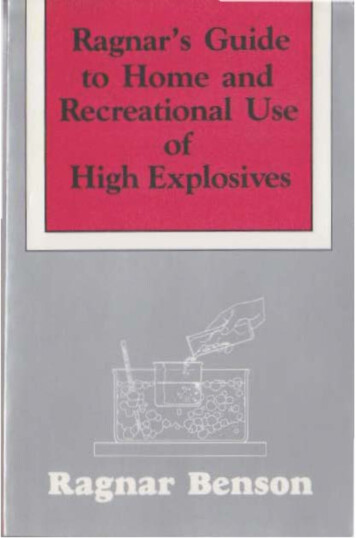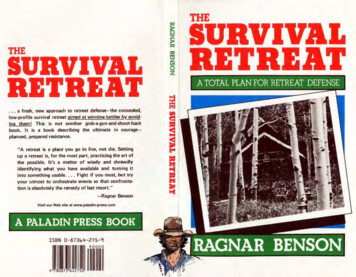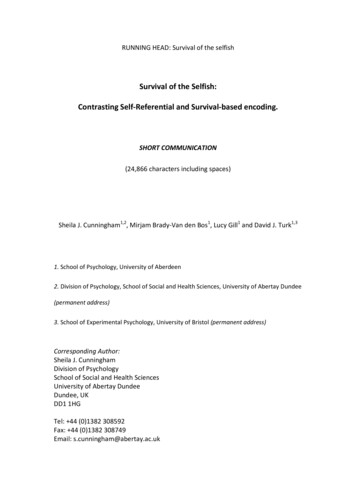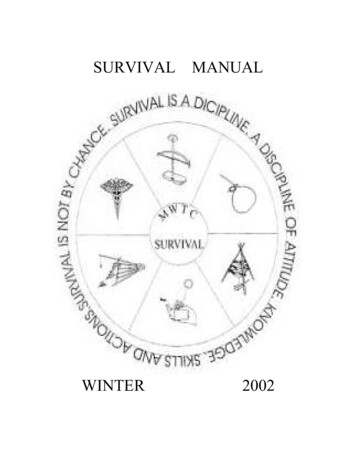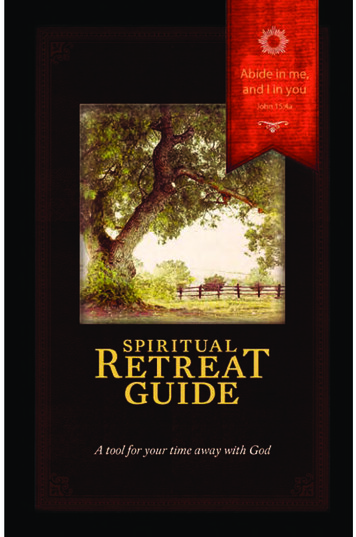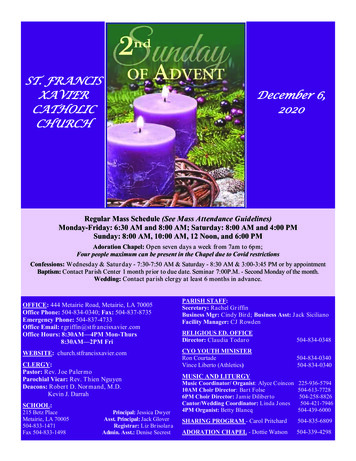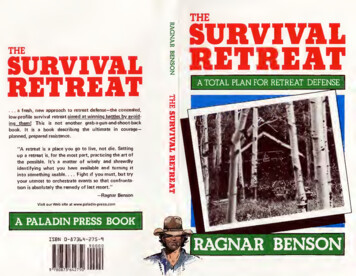
Transcription
SURVIVAL. a fresh, new approach to retreat defense—the concealed,low-profile survival retreat aimed at winning battles by avoid ing them! This is not another grab-a-gun-and-shoot-backbook. It is a book describing the ultimate in courageplanned, prepared resistance."A retreat is a place you go to live, not die. Settingup a retreat is, for the most part, practicing the art ofthe possible. It's a matter of wisely and shrewdlyidentifying what you have available and turning itinto something usable Fight if you must, but tryyour utmost to orchestrate events so that confronta tion is absolutely the remedy of last resort."—Ragnar Bensonvisit our Web site st www.palBdin-press.cornA PALADIN PRESS BOOKISBN 0-fl73m-B7S-'1SURVIVALRETREATA TOTAL PLAN FOR RETREAT DEFENSETHE SURVIVAL RETREATRETREATRAGNAR BENSONTHETHE
Also by Ragnar Bcdsod:Acquiring New IDBreath of the Dragon: Homebuilt FlamethrowersBuU's-Eye: CrossbowsDo-It-Yourself MedicineEating CheapHardcore PoachingHome-Built Claymore Mines; A Blueprini for SurvivalHomemade C-4: A Recipe for SurvivalHomemade Grenade Launchers: Constructing the Liltimaie Hobby WeaponLive Off the i-and in the City and CountryMantrappingModem Survival RetreatModem Weapons CachingRagnar's Action Encyclopedias. Mrlumes 1 and 2ContentsRagnar's Big Book of Homemade Weapons:Ragnar's Guide to Home and Recreational Use of High Ex osivesRagnar's Guide to the Underground EconomyRagnar's Ten BesiTVapa. And a Few Others That Are Damn Good, TooSurvival PoachingSurvivalist’s Medicine ChestSwitchblade: The Ace of tion.1Why Retreat?.7What Is a Retreat?.15Practical Retreat Designs.21What Do You Have to Protect?.35Getting to Your Retreat.41Retreat Location.49Who Is the Enemy?.57The Psychology of Defense.65The Rctreater’s Arsenal.75Beyond Firepower.85Making It Difficult.91What if It Comes to a Fight?.101The Ultimate Scenario. 107Appendix I—Commercial Sources. IllAppendix II—The Defensible RetreatCheck List.117Bibliography. 125
nk-and-arm-to-the-tceth book about sus taining a three-day firefight with your neighbors afterthe collapse. My contention is that guns are one of thelast, and probably the least important of the major as pects of defending your retreat.Instead, I have attempted to put together informa tion of genuine practical value that will really teach sur vivors how to protect their retreats. In doing so, I havedrawn heavily on my own experience as well as that ofa number of people who have made it through tough,no-holds-barred survival situations. Since no work ofthis nature could, or should, hold itself out as being thefinal word, I have also cited quite a lot of current liter ature.Survivors with some military background will prob ably not substantially disagree with my basic retreatdefense premises. Conflicts, however, will arise whenthis material is compared with the theories of thosequasi survivalists whose volumes of writing often vastlyexceeds their on-the-ground experience. I suspect thatthe main reason some of these people have so manyfollowers is because many Americans want a good ex cuse to buy a lot of guns. Some of the armament gurus1
2RAGNAR BENSONINTRODUCTION3will gladly justify purchasing a whole roomful of fire Around noon on the fifth day we pulled up early andarms!camped off the road in a small, obscure wash aboutHowever, survival, and especially retreat defense, is aforty-five kilometers from our target village. The menpersonal matter. It is not something that can be decidedspent the afternoon sleeping and cleaning their weapons.on for you by your neighbors, your friends, your priest,Shortly after dark, the eleven of us pulled out again,survivalist writers like myself, or the government. Allnow heading directly for our assigned target. Our mis that experts like myself can do is offer suggestions,sion was to hit a village of about ten thousand souls ahopefully based on good, solid experience. You, the sur few kilometers across an ill-defined border. The villagevivor, will have to be the final judge of that.had been the source and refuge of some antigovernmentBecause retreat defense is an individual matter, I feelterrorists, and the central authorities for whom we wereyou should acquire as much on-the-ground experience asworking had decided that it was time to “give some in you can. When you do, it will become painfully obviousstruction in foreign policy.” As the only “unofficial”that some of the gurus don’t have as much experience asmember of the group, I had a rare opportunity to seeyouhow foreign policy is practiced in some of the lessthoughttheydid.With somefield experiencebehind you, you will find it infinitely easier to developand implement your own plan.developed nations.Seven kilometers north of the village our columnIn late December 1967, I was traveling with a smallsplit into two groups. Another fellow and I headedprivate military outfit hired by a central African govern southwest on foot; the rest drove northwest on the roadment that has long since dropped into the bottomlessacross the high savannah. Recent burning had clearedpit of oblivion. Our raiding party—that’s all it reallymost of the tangle; we had a relatively pleasant walk inwas—consistedthe cool, damp moonlight.of elevendirty,grungy, godforsakenEuropeans mounted on three Rovers, one pulling aJust before first light, we reached our assigned posi trailer with gear and ammo, one with a mounted .50tion on a gentle rise about twenty meters above andcaliber machine gun, and the third with a socket and tireeighty meters to the side of the dusty, rutted road lead setup for a small clip-fed .30. One of our guys was aing to the village. Our instructions were to place our third generation Kenyan who had first fought as a teen selves about one to one and a half kilometers out. Sinceager during the Mau Mau Rebellion. The entire crew wasneither of us had ever been in the area before, we couldhard-core refuse, swept up in the maelstrom of dirtyonly guess at our exact location. The village was not inlittle African wars that no one has ever heard of.sight, although we could hear cattle now and then. TheWe were on the road for six days. Much of that timewas spent fooling around doing nothing while we lulledwind was wrong to smell it.As the sky grew lighter, 1 could make out aboutthe bush telegraph into indifference. Some days ourtwelve Hunter’s hartebeest moving across a grassy flatlittle column made but thirty or so kilometers when weupwind of us. They moved hesitantly, taking a little nipcould easily have done eighty. But our leisurely paceof new grass now and then. As soon as I could see wellandenough, I picked out a nice young buck and droppeddeliberatelycircuitousrouteprecludedthat.
4RAGNAR BENSONINTRODUCTION5him with one shot from my Browning .338. The noisethe more so for the presence of the remains of the oneof the pistol shot echoed through the gentle hills. Myhundred fifty or so cows that had been cau t in thecompanion was so startled, he fell off the termite nestambush. The only redeeming factor 1 could think of wason which he had been sitting.that, in their rush to escape, the men had abandonedAccording to the instructions we had been given, wetheir women and children. They had tried to save onlywere supposed to shoot the first villager who happenedtheir most precious possessions and their own lives,along the road that morning. As it worked out, thewhich was why so many cows got it. Women in Africahartebeest was a better choice. There was plenty ofare treated worse than cattle. The upside of the ambushbloodshed a bit later without our adding anything to it.was that, in comparison to the men, very few womenAs an extra benefit, we enjoyed fresh meat that after got hurt. Usually it’s the other way around.noon for the first time in six days.There are four valuable lessons in this story for theI set to work gutting the critter and was almostretreat defender. The first is don’t ever become a tar done when the other group’s guns opened up. The planget for those who can hurt you. Be inconspicuous andhad called for the two of us to create a diversion thatstay out of sight. The wise survivor does not become awould scare the villagers out to the other side of townlesson in foreign policy.into range of the machine guns. Apparently my one shotThe second is that no matter how well armed youhad put the plan in motion. We could hear the steadyare and how hardened your retreat, you can’t hold outpurr of the .30 along with the metered fire of the FNs.even briefly against a well-trained, well-armed militaryOverthump-thump-force. We knew that some of the African villagers hadthumped regularly. After about five minutes the shoot weapons and were fairly proficient with them; yet theying subsided. We walked cautiously on up toward thewere spooked and overrun in minutes.allthat,thegiant.50calibervillage on the dusty little road. Had we even supposedThe third lesson may be obscure at this point: it isthat anyone had anything more than a gas pipe gun, itdon’t ever become a refugee. Stake out your home turfwould have been an act of incredible bravado.and stay there, defending it as best you can.In those days the flow of Soviet weapons into theregion had not yet reachedFourth and last, we should never have been able toflood stage. I felt safewalk through that village after the shooting. You shouldenough, but a kind of sick self-consciousness made menever give up your ability or desire to resist. Thiswant to melt into the stinking, dry village dirt as weassumes that you have both the equipment and thepassed through. Most of the villagers had fled. A fewdesire to begin with. In the case of the African village,women and children, old men, and a cripple or two werethe outcome would have been the same; it just wouldn’tallhave been so damn easy. A psychological element ofthatremained.Thosewhocouldn’trunawaywatched us pass with horribly scared white eyes fromretreatbehind the boonahs and randaavels. The few shops wereknown to possess neither the means nor the will toall deserted.fi t.The scene on the other side of town was horrible.defenseis forfeited when the defenders areAs I said at the beginning, a lot of things are more
6RACNAR BENSONimportant than guns. In this example, we could listthings like regular patrols, sentries, a plan of resistance,a basic defense network, rules against openly and notor iously harboring terrorists, and a set of values based onsomething more precious than cows.Each clement has its place in a viable retreat defensestrategy, and each is, in its way, as important as guns.The important point is that defenders should under 1. Why Retreat?stand the rules and then set out to play the game wiselyand with determination. To that end, I dedicate thisbook to those who are willing to defend their retreatsno matter what the cost—enen if it means staying out ofa fire fight.Why RETREAT?” IS A QUESTIONthat 90 percent of our population cannot and will notanswer.If they could, that same 90 percent of ourfriends,neighbors,andcountrymenwouldhave toadmit that things may not continue on as they are now.They would also have to admit that they will need aretreat—something completely impossible for the aver age American to do.Certainly part of the problem lies with the hope lessly pessimistic attitude the peacemongers have en couraged. According to several national polls, a mini mum of 80 percent of us genuinely believe that no onewill survive a general nuclear attack. These people havegiven up already.I certainly plan to make it through a nuclear attack,and 1 sincerely believe you can make it through as well.If you doubt this, try reading Bruce Clayton’s excellentbook Life After Doomsday (see bibliography). It willdo more to instill spirit and hope than anything else Ican think of. Other worthwhile reading is the editorialseries run by the Wall Street Journal in early 1982. TheJournal did an extremely credible job of tracing theantinukepeacemovement’sleadershipbackto theKremlin and of documenting the fact that the Soviets7
8RAGNAR SEASONWHY RETREAT?9genuinely believe they can emerge victorious from aStarting when 1 was a young man in Cuba on my firstnuclear confrontation. The Journal's material closelyinternational assignment—is to evaluate accurately andparallels my own experience and coincides with whatcalmly what sort of danger you will actually be facing.my mother, who was Russian, tau t me about dealingThis step is so important that 1 have written an entirewith the Soviets.chapter on the subject. What one must know here is notBesides the nuclear threat, there is also the very realwho, but in a broad sense, what. Is it chemical warfare,possibility of economic collapse or social breakdown,pestilence, nuclear warfare, famine, an occupying army,either of which would sweep away most restraints thatearthquakes, floods, or rioting plunderers? To simplifywe take for granted in our society. The French politicalmatters let me say that the basic defense concepts arephilosopher Frederic Bastiat pointed out that govern pretty much the same no matter what the threat. Thements that promise things to their people end up dis only things that really change are the defense tools youappointing most of them when the politicians can’tstockpile in your retreat. These can vary, depending onreally deliver on those promises. In other words, thewhat it is that seems likely to get you. Basic strategies,more promises a government makes, the shakier it be however, remain unchanged for the most part.comes. The end result is either anarchy or a dictator ship.ment attempting to suppress American guerrilla fightersFor instance, I feel that the danger of our govern At this writing, unemployment is at a forty-year, 11in rural areas of our country is very real. The Sovietspercent high. Still, Americans call upon the governmenthave said over and over that they intend to strike first atto “do something.” I’ll leave it up to the reader to de our military bases; having destroyed our ability to retali cide if the greater danger lies in nuclear confrontation orate to any meaningful degree, they will then threaten todestroy twenty or thirty large cities if we don’t surren in governmental breakdown.As I said earlier, the first step in preparing to surviveder. Given the records of most of our politicians, Iis to admit that some kind of collapse will eventuallybelieve we will, as a country, capitulate. When there isoccur and that during that time you, your family, andnobody other than the victims around to complain, theyour friends will need a suitable place to hole up.Soviet record is consistent—witness Laos, Cambodia,Having made, what for many is an incredibly tough de Vietnam, and Afghanistan. They will move in using gascision, you must also settle two more issues before em and chemicals to liquidate people and poison farmlands.barking on a program to build your retreat.For this reason I keep decontamination suits and filterFor the purposes of this book and for your survivalbreathing apparatus in my retreat, something I wouldin general, I will not agree that you really believe younot do if all I expected to face were looters rioting aftercan and will survive, unless a plan of action accompaniestheir food stamps were cut off.that belief. In other words, you must believe enough tostart doing something,and that something must bebased on a credible, realistic plan.The next step—one I have faced many times overSetting up a retreat is, for the most part, practicingthe art of the possible. It’s a matter of wisely andshrewdly identifying what you have available and turn ing it into something usable. People who can do this
10RACSAR BENSONWHY RETREAT?easily and well we describe as having street sense. Streetonto? How will they be moved? All are perfectly validsense is acquired throu experiencing adversity andquestions which have, of course, no rational answers.11desperation. Those who have street sense have a tremen dous advantage over those who have never had to go outand “scratch shit with the chickens.”About three years ago the editor of one of the majorSTAYING PUTAs a general rule the survivor is better off staying onhis home ground and building his retreat there. Rationalgun magazines mentioned to me that she appreciated aevacuation plans have their place, but in general the sur magazine article I wrote on urban survival. Up to thatvivor will find it easier to plan, stock, move to, and de time, she said, she had always assumed that “everyonefend a retreat that is either in his home or at leastliving in places like New York, Chicago, or Los Angeleslocated in his home territory.was simply going to die.” The only way she could ex In my book Eating Cheap (see bibliography), I de pect to survive was to leave New York-something shevoted a chapter to the art of doing business with ruralcould not do then and something she felt would be “im possible later, after the collapse.”people. I have found that farmers are so different inMany urban survivors believe that they must evac prior experience in dealing with these people, it is abso their ways of thinking and acting that unless you haveuate to a rural retreat to make it. Having lived in bothlute idiocy to leave the city in an emergency and expectenvironments and having watched several mini-collapsesto coexist with them. You will be dead and gone withinin Africa and the Middle and Far East, I know this is nota month if you try it.true. People who are not rural by nature and upbringingshould stayThere are some exceptions. Wealthy people whoaway from farms. They simply will nothave built rural retreats or members of survival unitsmake it in a tightly knit agricultural environment. If youwho have established safe areas in the country arc twohave street sense rather than field sense, stay on theexamples. However, remember that these people are notstreets. People survive in cities and you can, too, espe refugees; theycially in the U.S. where food is currently cheap and canplans which they can implement when the time comes.be stockpiled without much difficulty or expense.The fact that these plans call for them to move to theCurrent civil defense thinking envisions turning ourentire nation into a mob of refugees. Lacking an ade havewell-thought-throughevacuationcountry has nothing to do with my original warning.They will not become refugees.quate shelter system, the program calls for evacuatingBut getting back to the two important questions Ithe cities and sending everyone out into the country toalluded to earlier, the first point one must consider is,live until the bombing is over. For survivors who either“Where will I stay during and after the collapse?” It islive in the country or would be pushed out of the city,absolutely essential that survivors have a clear, concise,a number of red flags should go up. Where will all thesewell-thought-through plan that is perfectly plausible tomillions of people go? What will they eat? Whose toiletimplement the moment a national or regional crisiswill they flush? Whose property will they flood overoccurs that honestly, practically addresses this issue.
12RACNAR BENSONREFUGEESWHY RETREAT?13other things, a helicopter pilot, a seasoned paratrooper,As I implied in my introduction, there is nothinga good boat captain, a jo er, a motorcycle operator,more tragic and more pitiful than a refugee. Refugeesand a long-distance patrol leader. All survivalists must beare people without hope who have left their homes toversatile with strong skills in a number of areas. Yetrun ahead of the holocaust, never in control of theirthis fellow amazed even me. Because the subject of get own destinies. They are people who must rely on theting to one’s retreat is so important, I have devoted ancharity of others until their time runs out and they die.entire chapter to this subject.I have seen them in Sudan and in the Northern FrontierDistrict of Kenya, in northern Somalia, Ethiopia, Jordanand Lebanon, on the southeast coast of Florida, and inscores of other places throughout the world. All of thesepeople have one thing in common: utter hopelessness.The important lesson you can leam from this bookis never, under any circumstances, ever become a refu gee. Evaluate your situation and circumstances. Makeyour plan and then, by God, win, lose, or draw—evenwhen its weaknesses start to show up—stick with yourprearranged scenario. Be flexible, versatile, and sensitiveto what’s happening; but most of all, implement yourplan and basically stick with it. Die if you must, but dieon your home turf with your face to the wind, not insome stinking hellhole 2,000 kilometers away, amongpeople you neither know nor care about.1 was marginally involved when Saigon fell to theNorth Vietnamese. I would have had a tougher time ifI hadn’t befriended an Agency employee who had agoodideawhatwascoming and had meticulouslyplanned out three separate, workable evacuation routes.Each made use of completely different modes of trans portation and did not depend on the success of theother two. When the time came, he put the best planunder the circumstances in motion, and we got out.Even more than defending a retreat, getting to a safearea requires a great deal of skill. This guy was, among
2. What Is a Retreat?ARETREAT IS A PLACE WHEREyou will find the shelter and protection, food and water,medicine and warmth you prepared for yourself untilsociety returns to its normal, nondestructive, n”leavessomething to be desired, but even in places like Iran,Cambodia, and Chile, some sort of normalcy eventuallyreturns.Usually this takes about two years. There is first s. This is followed by a time of reaping, whenthings don’t necessarily get worse but people continueto die by the thousands as a result of what has pre viously occurred. This stage is somewhat like the crashin deer and rabbit populations: as soon as the numbersare down, the situation stabilizes.The trick here is to have a retreat prepared whereinyou can be one of the survivors. Your retreat can be inthe city, in the country, where you work, or at a closefriend’s or relative’s place. The important point is thatyour retreat is a place where you go to live through thecrisis, and not a hole you crawl into to die.A retreat must be out of the mainstream of lootingand burning or be camouflaged and fireproofed to es15
RAGNAR BENSON16WHAT IS A RETREAT?17cape these hazards. Since there is a great likelihood ofnuclear, biological, or chemical warfare, a retreat mustprotect from these dangers as well. It has to be stockedwithfood, fuel, and clothing and contain the coremeans with which to start a new life after the collapseand resulting dislocations.I know scores of people who have set up their re treats in the basements of their houses. Others haveapartments in large concrete buildings that will probablydo almost as nicely. A farmer I know plans to use a rootcellar on his land . . . after dynamiting the two roadbridges leading across the creeks onto his property. An other man intends to pull a self-contained travel camperinto an underground parking garage near his home.A group in Washington State plans to establish atent camp in a sheltered valley along a small river, whilethe inhabitants of a small community in southern Utahintend to live pretty much as they do now-except thatall contact with the outside world will be severed. Theyplan to work together to be completely self-reliant.Their only requirement is that all members must beMormon and must do their share of work. These peopleare rough on folks with a welfare mentality.In suburbia I have seen garages and recreation roomsoutfitted with extra-strong walls and roofs, filtered ven tilation systems, and food and water supplies that willsupport the inhabitants for months or even years. Shopbuildings are another common retreat location. With abit of prior planning and work, these types of buildingscan be made into outstanding retreats.Theimportantpointis that survivors who willoccupy these retreats have turned off their tubes andput some thought into evaluating possible dangers andwhat they will need to do to survive. I have a closefriend who claims that a retreat is 90 percent psycholo-This home also serves as a survivallst's retreat, (t was buMt with twelve-inchconcrete walls in the basement and butted into the side of a hill. Trees pro vide camouflage and fuel for cooking and heating via the fireplace.
18RAGNAR BENSONWHAT IS A RETREAT?gical; perhaps he is right. Some retreats are so simpleable to fly it? My last-ditch plan to buy or steal athat they are nothing more than a hole in the backyard.motorcycle may not even be viable. Only time will tell.What makes them a retreat per se is the will and deter mination of the owner.19Even more than my domestic plans to reach my re treat, I amconcerned about the number of foreignI myself have almost always lived in the country.assignments I have recently received. In time of crisis,My retreat is in my home, built over a large, sturdy base how will I get back from the Philippines, Sudan, India,ment into the side of a mountain. In many ways it is theor even southern Mexico?classic “desert island” hideaway that many survivalistsThe city dweller hasfewer of these worries. Asfantasize about. The foundation has thirty-centimeterBruce Clayton points out, the dangers of nuclear attackwalls and is dug into three meters of solid earth. Threeare greatly exaggerated. The most serious dangers will bestoriesand mass protectionmuch the same for the country dweller. In Live Off theagainst nuclear dangers. I have my own well, a dieselLand in the City and Country (see bibliography), I rec generator, four years’ supply of food, medical supplies,ommend that the city dweller stockpile twice as muchabundant guns and ammo, a large garden spot, storedfood and water. The plan for the urban survivor involvesseeds,total seclusion for months on end until it is safe to comeabove providefueloil,distancechemicalsandfertilizer, decontami nation and breathing gear, explosives, and so on.This may seem ideal, but am I really better off thanthe city dweller who has reinforced a basement in a con out. Then you can barter your skills and the hardwareavailable in the city with rural people who will becoming to town for items they can’t make.crete building? He might have to store a bit more foodThe dieback will have occurred. Your retreat willthan I do, but even after the collapse he will have betterhave served its purpose, and it will be time to startaccess to manufactured goods. In many respects, his re building a new economy.treat will be more secure. I suspect that bands of scaven As 1 have pointed out, a retreat is a place you go togers will be scouring the country looking for places likelive. Not die. It is a place out of the mainstream ofmine.events that contains the means to survive without out Even in remote areas like mine, there will bemany ugly situations as looters attempt to gain theirside support. It is defensible and is put together with ameans of survival by force. Furthermore, the city sur realistic understanding of what the dangers will be. Itvivor will be in or near his retreat when the time comes.is both a plan and an inventory.1 may have a struggle just getting to my retreat if I amtraveling, as is often the case.Building the retreat itself is almost always anticlimactic. The hardest part is admitting you need a retreatLike most rural people, I can’t make my living in theand then putting together a plan. It’s like the country ofcountry. I will probably be working in a large city whenSwitzerland: the mountains constitute a mighty fortress,the collapse occurs. Perhaps I will have some warningbut as the Swiss admit, one must know how to man theand will be able to take off with the two extra cans offortress and be willing to do so when the time comes. 1gas that I always keep in the car. Perhaps not. There istrust this chapter will break the impasse for you andalways my airplane,that you will get on with the work at hand.which I keep near—but will I be
3. Practical RetreatDesignsNoMATTER HOW YOU CUT IT,the best, most practical retreats are those built under ground.This is not to say that aboveground retreats can’t beput together. Some have worked admirably well for longperiods of time, especially in larger cities. But it iseasier, cheaper, and better to go underground, especiallyif you must plan for the full spectrum of problems. Re treats, for instance, should be reasonably airtight. Con stant temperature control is important, as is fire resis tance. As a means of protection against nuclear blastforces, underground shelters are almost ideal. Anythingelse is a lot more trouble.One of the best books on retreat construction isImprovised Fallout Shelters in Buildings, published inAugust1972 by the University of Idaho College ofEngineering. Its information pertains to using existingbuildings, from grain bins to old stores, for retreats. Vir tually the only situations the authors endorse are base ments. The Office of Civil Defense also has several publi cations on retreat construction; all but one of these arefor underground designs. These include Family HomeShelter Designs (PSD F-61-1), Home Shelter (H-12-1),and Aboveground Home Shelter. One of the tricks I was21
22PRACTICAL RETREAT DESIGNSRAGNAR BENSON23reminded of in these pamphlets was the extensive useof sandbags. Perhaps the more correct name should becloth bags filled with earth. Ex-military people will re member spending hours filling and stacking sandbags toform bunkers and gun emplacements. Retreaters willlikely find themselves doing the same thing the firstweeks after the collapse.Explosion-proof structures must be ductile; meaningthey have to give an
—Ragnar Benson . visit our Web site st www.palBdin-press.corn . A PALADIN PRESS BOOK . ISBN -fl73m-B7S-'1 . RAGNAR BENSON. THE RETREAT. A TOTAL PLAN FOR RETREAT DEFENSE . SURVIVAL. THE . RETREAT . Also by Ragnar Bcdsod: Acquiring New ID . Breath ofthe Dragon: Homebuilt Flamethrowers . BuU's-Eye: Crossbows .

